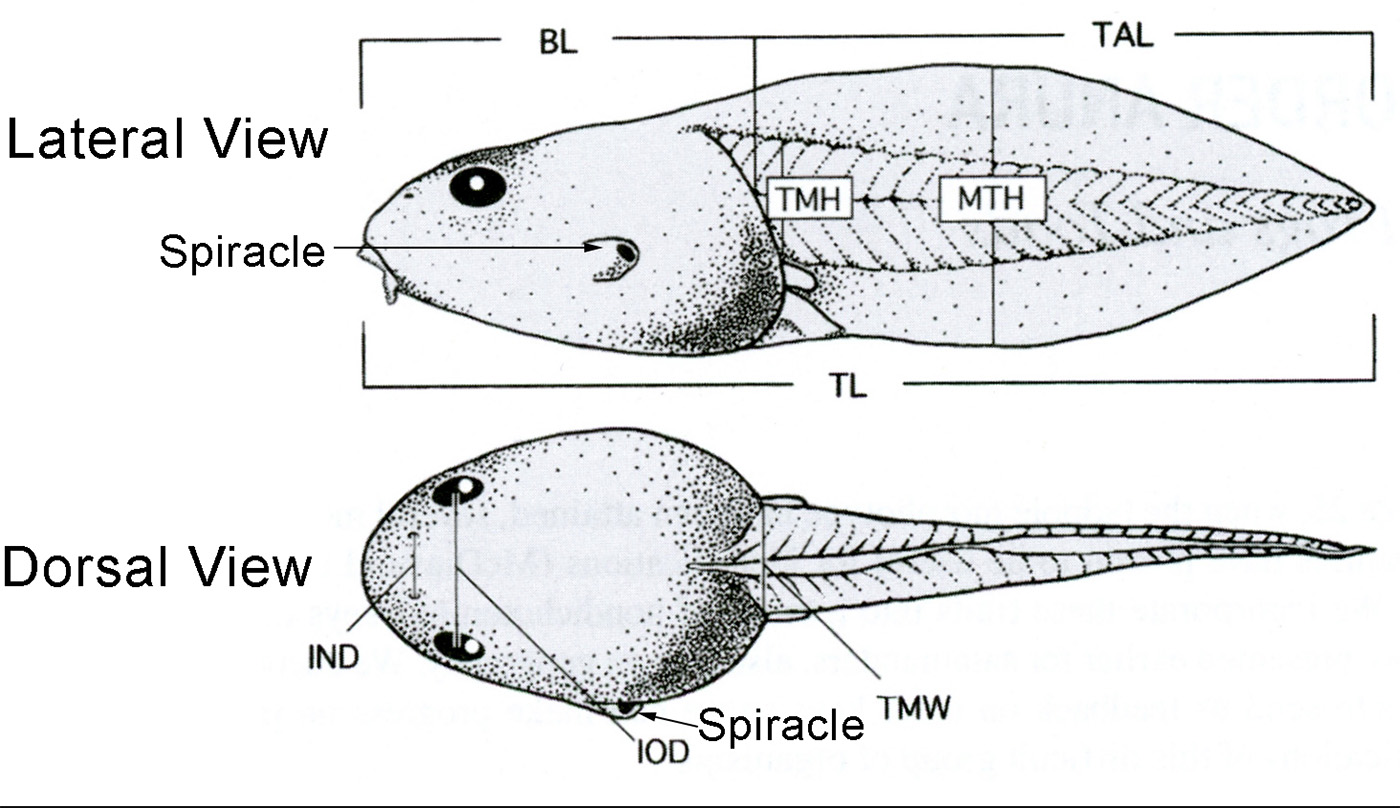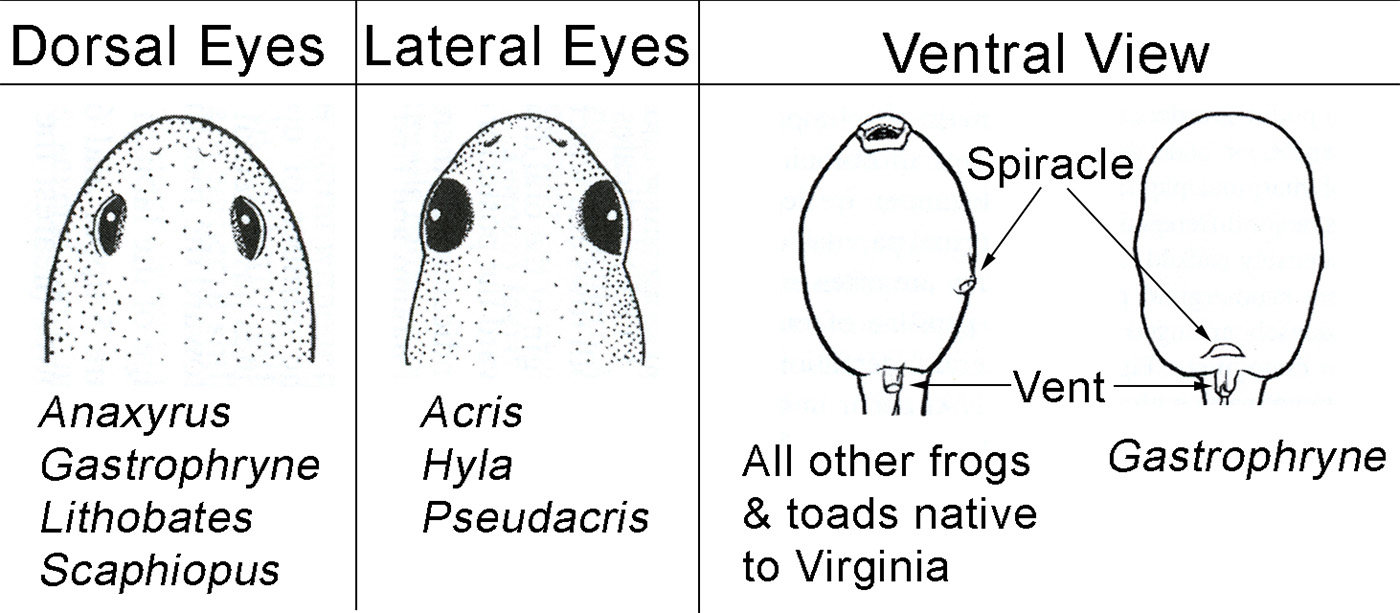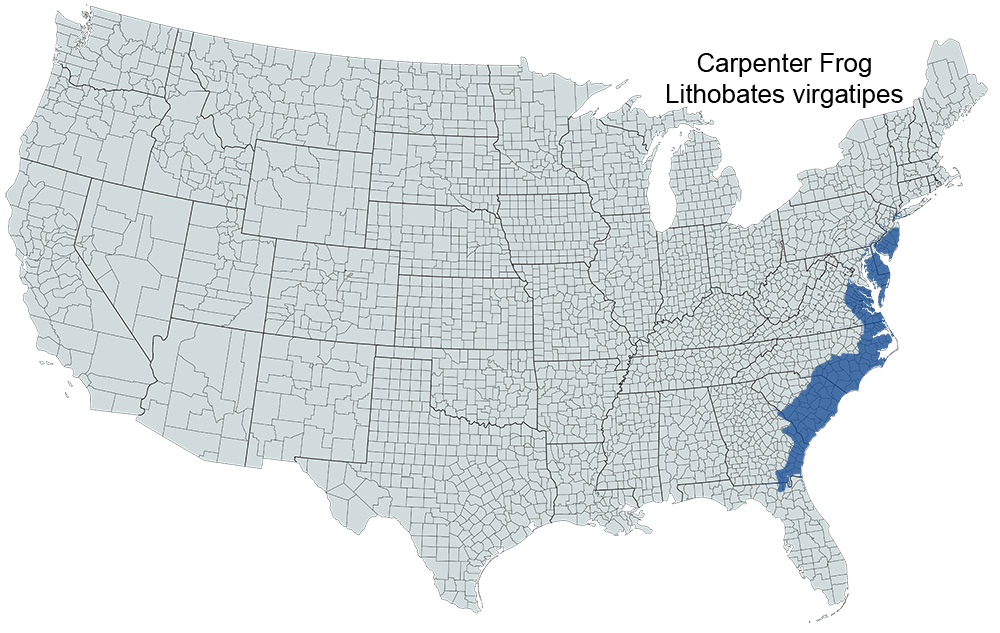Carpenter Frog
Lithobates virgatipes
Common Name: |
Carpenter Frog |
Scientific Name: |
Lithobates virgatipes |
Etymology: |
|
Genus: |
Lithobates is Greek, Litho means "A stone", bates means "One that walks or haunts." |
Species: |
virgatipes is Latin meaning "striped foot" Referring to the striped markings found on rear feet. |
Average Length: |
1.6 - 2.6 in. (4.1 - 6.7 cm) |
Virginia Record Length: |
|
Record length: |
Physical Description - This is a medium-sized ranid species ranging in length from 41 to 67 mm (1-5/8 to 2-5/8 in). It is generally brown in color with irregularly shaped dark markings on the dorsum. There are 4 yellowish dorsolateral stripes and the rear of the thigh has alternating light and dark stripes. These markings give it excellent camouflage. The ventrum is whitish with dark mottling which may be absent in pale individuals. Dorsal surface of the legs and cloacal region is slightly granular in comparison to other skin surfaces. The hind feet have long, completely webbed toes. Tadpoles live over 1 year in the larval stage and thus can grow very large (average 55mm, up to 100mm). The tadpoles are brown with a dark lateral stripe on the tail musculature and a characteristic narrow dark stripe on the dorsal tail fin.
Historical versus Current Distribution - The historical range of Carpenter Frogs (Lithobates virgatipes) is unknown. Current distribution is in the Atlantic Coastal Plain from southern New Jersey to southeastern Georgia and two counties in northeastern Florida (Gosner and Black, 1968; Christman et al., 1979a; Ashton and Ashton, 1988; Conant and Collins, 1998).
Historical versus Current Abundance - These frogs may be common locally in some areas, but most populations consists of small numbers of individuals (personal observations).
Life History Features - The life history and ecology of this species were summarized by Wright (1932), Wright and Wright (1949) and Standaert (1967).
Breeding - Breeding is aquatic.
Breeding migrations - Breeding migrations do not occur because adults live in the breeding ponds. Initiation of the calling period in Virginia occurs in April, but I have heard calls in March during warm spells. Calling season in New Jersey, Virginia, and North Carolina is late April to early August (Given, 1987; Mitchell, 1998; personal observations). Males call from open water usually while sitting on aquatic vegetation. They have a prolonged breeding season, generally May–July. Depending on the breeding site (Given, 1988a), males call on 4–94 nights of the generally 3-mo breeding period (Given, 1988b). Observations of ampletant pairs are rare, but have been observed from 26 April–27 July in New Jersey (Given, 1988b).
Breeding habitat - Carpenter frogs breed in permanent, low to high acidity sphagnum ponds, beaver ponds, freshwater marshes, interdunal cypress swales, and pocosins (Wright, 1932; Wright and Wright, 1949; Mitchell, 1998, personal observations; Zampella and Bunnell, 2000). Number of submerged stems is positively correlated with the number of calling sites (Given, 1988b), indicating that vegetation structure of wetlands is an important component of breeding habitats.
Egg deposition sites - Eggs are laid in small masses attached to vegetation slightly submerged below the water's surface (Livezey and Wright, 1947). Carpenter frog embryos tolerate more strongly acidic water than most eastern temperate zone frogs. Successful hatching occurs as low as pH 3.8, but that concentration produces some abnormal development (Gosner and Black, 1957b).
Clutch size - The number of eggs/mass is 200–600 (Wright, 1932; Livezey and Wright, 1947).
Altig & McDiarmid 2015 - Classification and Description:
- Eastern Clump
- Arrangement 2 - Eggs oviposited as large clump, surface lobate even in old, melded clumps, structure is maintained until hatching.
- Sub-arrangement D - Eggs deposited in swampy nonflowing water; Ovum Diameter 1.4-1.8 mm; Egg Diameter 3.8-6.9 mm; 1 jelly layer; clump diameter 75-100 mm.
- Arrangement 2 - Eggs oviposited as large clump, surface lobate even in old, melded clumps, structure is maintained until hatching.
Larvae/Metamorphosis - The extended larval period lasts about 1 yr, and tadpoles overwinter in breeding ponds. Newly metamorphosed animals emerge in August–September from larvae hatched from eggs laid the previous summer. Size at metamorphosis was reported to be 23–31 mm SVL in Georgia (Wright, 1932) and 28–36 mm SVL in New Jersey (Standaert, 1967).
Tadpoles:

| Lateral View | Dorsal View |
|---|---|
| BL = Body Length | IND = Internarial Distance |
| MTH = Maximum Tail Height | IOD = Interorbital Distance |
| TAL = Tail Length | TMW = Tail Muscle Width |
| TL = Total Length | |
| TMH = Tail Muscle Height |

Juvenile Habitat - Apparently similar to that of adults. Juveniles are not known to disperse from breeding sites, and this size class is caught frequently in aquatic habitats (unpublished data).
Adult Habitat - Adults do not venture far from water and apparently remain in wetlands in all seasons. Buhlmann et al. (1994) found only three Carpenter Frogs in pitfall traps in upland habitats during a 6-mo trapping period in southeastern Virginia, suggesting that few move overland.
Home Range Size - Unknown.
Territories - Male Carpenter Frogs are territorial and use physical interactions and vocalizations to defend territories (Given, 1987). Territory size is 0.5–6.5 m in diameter (Given, 1988b). Larger males are aggressive to smaller males and exclude them from territories. Males exhibit high site fidelity to their territories.
Aestivation/Avoiding Dessication - Unknown.
Seasonal Migrations - Carpenter frogs apparently do not migrate. Standaert (1967) noted that several adults moved from a large breeding pond to a series of smaller ponds nearby, where they overwintered.
Torpor (Hibernation) - Overwintering sites are under water, usually in permanent breeding ponds.
Interspecific Associations/Exclusions - Carpenter frogs are sympatric with Eastern Cricket Frogs (Acris crepitans), Southern Cricket Frogs (Acris gryllus), American Toads (Anaxyrus americanus), Fowler's Toads (Anaxyrus fowleri), Southern Toads (Anaxyrus terrestris), Narrow-mouthed Toads (Gastrophryne carolinensis), Pine Barrens Treefrogs (Dryophytes andersonii), Cope's Gray Treefrogs (Dryophytes chrysoscelis), Gray Treefrogs (Dryophytes versicolor), Spring Peepers (Pseudacris crucifer), American Bullfrogs (Lithobates catesbeiana), Green Frogs (Lithobates clamitans), Pickerel Frogs (Lithobates palustris), and Coastal Plains Leopard Frog (Lithobates sphenocephalus utricularius; Gosner and Black, 1957b; Given, 1987; Buhlmann et al., 1994; Bunnell and Zampella, 1999; Mitchell, 1998).
Age/Size at Reproductive Maturity - The smallest mature male carpenter frog reported was 39 mm SVL, 1 yr following metamorphosis (Standeart, 1967; Given, 1988b). Males ≥ 47 mm SVL are mature. Corresponding data for females are not available.
Longevity - This species has lived as long as 6 yr, 2 mo in captivity (Snider and Bowler, 1992). Standeart (1967) and Given (1988a) noted that few adults marked in 1 yr were recaptured in subsequent years and suggested that adults in nature live ≤ 3 yr following metamorphosis.
Feeding Behavior - The diet of Carpenter Frogs has not been published.
Predators - Known snake predators are Nanded Watersnakes (Nerodia fasciata) and Northern Watersnakes (N. sipedon; Wright, 1932; Kauffeld, 1957; Gosner and Black, 1968; Palmer and Braswell, 1995). American Bullfrogs are usually absent where Carpenter Frogs are found (Zampella and Bunnell, 2000) or they only occur in small numbers (personal observations), suggesting that this predator may influence Carpenter Frog distribution and abundance.
Anti-Predator Mechanisms - Unknown
Diseases - Unknown
Parasites - Unknown.
Conservation - Carpenter frogs are listed as a Species of Special Concern in Virginia due to the low number of locations within the state (Levell, 1997; Mitchell and Reay, 1999). Ecologically, this species is one of the poorest known ranid frogs.
References for Life History
- Altig, Ronald & McDiarmid, Roy W. 2015. Handbook of Larval Amphibians of the United States and Canada. Cornell University Press, Ithaca, NY. 341 pages.
- AmphibiaWeb. 2020. University of California, Berkeley, CA, USA.
- Conant, Roger and, Collins, John T., 2016, Peterson Field Guide: Reptiles and Amphibians, Eastern and Central North America, 494 pgs., Houghton Mifflin Company., New York
- Duellman, William E. and, Trueb, Linda, 1986, Biology of Amphibians, 671 pgs., The Johns Hopkins University Press, Baltimore
- Martof, B.S., Palmer, W.M., Bailey, J.R., Harrison, III J.R., 1980, Amphibians and Reptiles of the Carolinas and Virginia, 264 pgs., UNC Press, Chapel Hill, NC
- Wilson, L.A., 1995, Land manager's guide to the amphibians and reptiles of the South, 360 pp. pgs., The Nature Conservancy, Southeastern Region, Chapel Hill, NC
Photos:
*Click on a thumbnail for a larger version.
Verified County/City Occurrence
Caroline
Hanover
James City
King and Queen
King William
Southampton
Spotsylvania
Sussex
CITIES
Chesapeake
Suffolk
Virginia Beach
Verified in 8 counties and 3 cities.
U.S. Range







